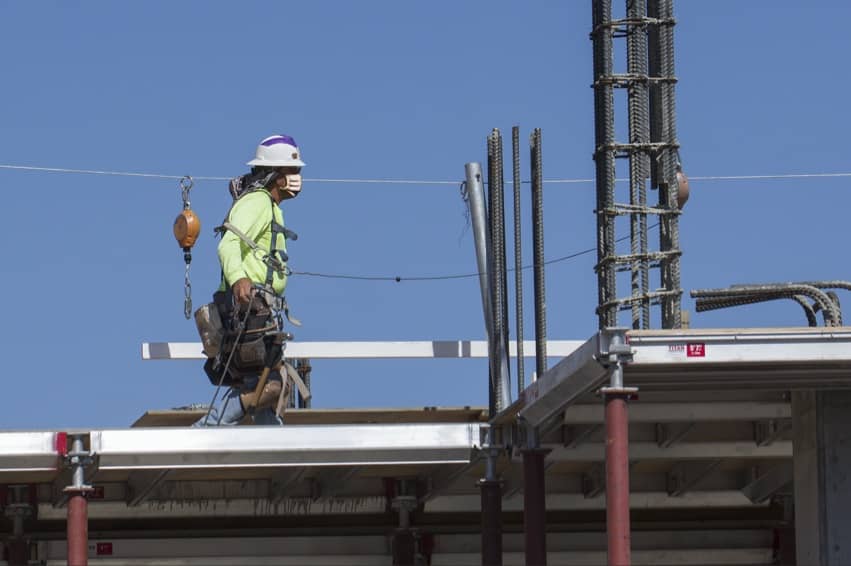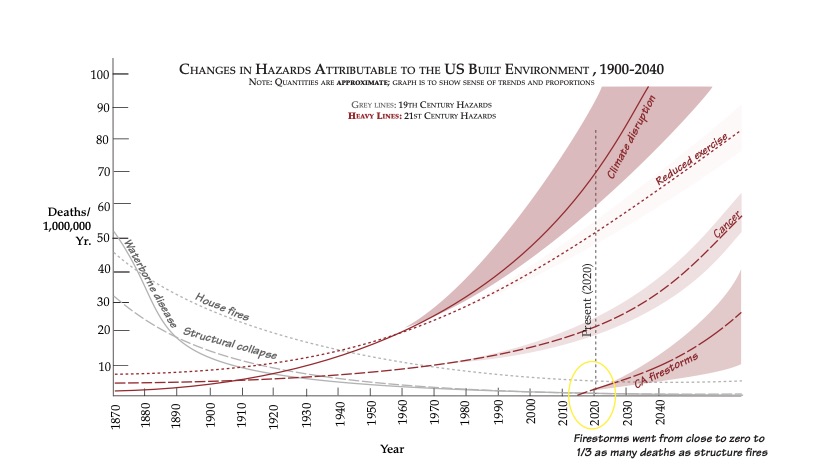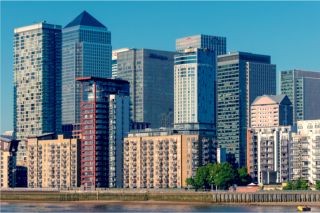
www.buildingsandcities.org/insights/commentaries/after-covid-19-regulation.html
After COVID-19: Opportunity for Changing Building Regulations?

Is the current situation an opportunity to undertake fundamental changes in the building regulatory process in order to ensure safe and healthy buildings?
David Eisenberg (Development Center for Appropriate Technology) and Rick Diamond (Lawrence Berkeley National Laboratory) consider the opportunities and challenges of building regulatory reform in the post-pandemic period.
An opportunity for changing building regulations?
The COVID-19 global pandemic has revealed flaws in many basic assumptions about how things work in our society-or fail to work. This has forced a recognition of the fragile connections, dependencies, and vulnerabilities inherent in the ways in which our buildings are designed, constructed, operated, and inhabited. The current situation is an opportunity to undertake fundamental changes in the building regulatory process in order to ensure safe and healthy buildings in a rapidly changing world.
Disruptions occurred in nearly every aspect of both the public and the private sector. The desire for a return to normal is powerful. Yet, while society's immediate attention remains focused on the pressing challenges of the current health crisis, three primary reasons emerge for making changes to building regulations:
Increased awareness of global connectedness
The pandemic has brought home-literally-the reality that we live in a globalized world, a manmade ecosystem in which people and microbes can travel anywhere in the world within hours. It has exposed the complexities, vulnerabilities and interrelationships of supply chains, infrastructures, economies, governance, and other human and natural systems. The implications of the pandemic for the design, maintenance, and operation of buildings present the opportunity to recognize parallels in other emergent trends and their related hazards, particularly those tied to urbanization and climate change. These challenges will be increasingly important in the rapidly growing cities in the Global South. Many of our basic assumptions about conditions, material and design choices, utility system reliability, etc need re-examination.
A renewed sense of urgency
The economic impacts of the pandemic are massive. The impact on the economy and the public expenditures required to maintain both public health and economic livelihood reveal the enormous financial cost. In addition, the human cost is tragic and inestimable. Anticipation and prevention are better (and less costly) than remedy. In the same way, the investment to reduce the risks and vulnerabilities associated with climate change is profoundly less than the financial, human and environmental costs inflicted by climate change. The costs of not addressing climate change now are large and growing at an accelerating rate. Regulatory change has been slow. Buildings and their designed-in demands, vulnerabilities and impacts last for a long time. What gets built going forward, and what is done with existing buildings, must be done in the context of these new realities, particularly to radically reduce energy demand and greenhouse gas emissions.
Increased expectations for leadership in governance
The current COVID-19 experience in the US has seen the public turn to government to provide information, guidance, and funding to address the situation. However, the decades-long efforts to shrink governments (at federal, state and local levels) has created crucial gaps and vulnerabilities. For example, many of the existing early detection and response systems for pandemics were dismantled and defunded, having been deemed unnecessary. This crisis has revealed the importance of foresight, competence, expertise, experience, transparency, and collaboration to address emergent hazards. Building codes, with their broad yet flexible requirements, can be an effective vehicle for protecting the public against changing conditions and hazards not previously recognized or addressed.
As the world pauses, reflects, and seeks to understand how to resume necessary activities without causing more harm, this is an opportune time to ask some key questions.
What challenges arise for building regulations in the post-pandemic period?
The pandemic has revealed flaws in many basic assumptions as hidden or unnoticed connections, dependencies, and vulnerabilities in both the public and private sectors. This pandemic's recent precursors (e.g. SARS, MERS, H1N1, Ebola and Zika) had triggered the development of global systems to identify and address outbreaks of new diseases early enough to prevent them from becoming pandemics. Advance preparations in some countries have resulted in low rates of infection or mortality.
Parallels exist between what we now face in the unfolding pandemic, and what most scientists tell us we are just beginning to face regarding climate change. What these large and serious emergent hazards share could provide a process for examining the goals and roles for building codes in protecting the public in a changing climate.
Public health officials face a perpetual paradox when dealing with emerging risks. If they act decisively and successfully, nothing terrible happens but they are criticized for overreacting. Similarly, when regulations work properly, the avoided catastrophes are invisible and the regulations that prevented them can be perceived as overly burdensome or unnecessary. Everyone sees the lives fire fighters save. No one sees the lives building codes and code officials save (including those of fire fighters). Slowly emerging hazards amplify the challenge. The difference between acting in a timely way to prevent a crisis and waiting until the crisis is fully developed before acting applies to climate change as well as a pandemic.

Figure 1. Research reveals that building codes have largely addressed the historic hazards attributable to the built environment while ignoring emerging hazards already dwarfing them. Figure used with permission from Art Ludwig, http://oasisdesign.net/design/legalizesustainability/#safer
There are many trends that reveal the significance of ignoring emerging hazards. Research by ecological systems designer, Art Ludwig (2020), led him to plot the declining historic hazards that building codes address - fire, structural collapse, sanitation, etc. - versus emergent hazards, including climate change, that already dwarf those older hazards (Figure 1). For example, he notes the continuing long-term trend in emergency calls to US fire departments. In 1980 only 27.6% of all these calls were fire-related but by 2018 it diminished to 3.6%. In that same 1980 to 2018 period, medical aid calls to fire departments rose from 46.6% to 64.1% of all calls (NFPA, 2020). Putting out structure fires, once the main purpose and activity of fire departments, now represent a small and declining fraction of what they do. Instead, they respond to heart attacks, car accidents, falls, and other emergencies. COVID-19 has only accelerated that shift.
A whole systems approach to building regulation is lacking. Ludwig points out that the shift to requiring residential fire sprinklers has created a greater potential hazard. When a wildland fire burns into denser, newer neighborhoods, the sprinklers in all the already burned houses can continue to drain the water system so the sprinklers in the houses facing the fire front have no water. This is an example of an emerging hazard exacerbated by climate change, coupled with the failure to consider the whole system and anticipate unintended consequences of a code change intended to promote greater safety.
How can we improve building regulations?
COVID-19 is showing us the need to identify, create, and maintain adequate response mechanisms for all kinds of emergent hazards. There is risk inherent in the current lack of a formal anticipatory process for emergent hazards within the building regulatory sector. That process would require connections with the science and public health sectors to translate the emergent hazards into appropriate and technically sound responses. This moment presents an opportunity to bring together the various communities of expertise tied to the built environment to begin to seriously think about how best to move forward.
The emerging climate crisis is both larger and broader than the current pandemic, but has slower impacts. The changing climate-related conditions, e.g., temperature, wind, flooding, droughts, fire, etc. affect buildings and cities. Building regulations (and other policy mechanisms) need to anticipate and address these hazards to ensure people will be protected, while also mitigating buildings' direct and indirect impacts on the climate (Eisenberg, 2016).
If the purpose of building codes is to safeguard the public from hazards attributable to the built environment, what obligation exists to address emergent hazards currently outside current regulatory scope or structures? How can protection be extended to the public, particularly to avoid unsustainable or harmful change?
A variety of ways already exist to include these new hazards. There has been a shift internationally toward performance codes, which are objective- or outcome-based, describing what needs to be achieved by the building and its component parts. Prescriptive codes have been the predominant form of codes, describing more specifically what has to be done and in some cases how it is to be done. Proscriptive codes describe what isn't allowed or what must be protected, essentially they are 'thou shalt not'-based codes proscribing actions that cause harm.
California is moving forward on 'outcome-based' codes, as a way to specify the desired and measurable outcomes that can be verified to ensure health, safety, and energy performance. In other places, voluntary 'stretch' codes have been developed to get new ideas into practice, familiarizing builders and code officials, before moving them into mandatory codes. This effort could be an effective strategy for convening and implementing a larger process engaging the missing areas of expertise and information that have kept the integrated realities of real-world hazards from crossing the artificial boundaries of regulatory silos.
Given the public health aspects of COVID-19, it is evident that a range of experts from outside the typical building codes community is a necessity. This broader approach will allow for a better understanding and integration of a wider range of public safety concerns than we've previously considered in codes.
Similarly, when considering the emerging hazards related to climate change, a process is needed for both initiating research and engaging a range of outside expertise and involvement that goes beyond the way we have previously thought about addressing building hazards. What gets built now will exist in different conditions than the historical ones on which so many code requirements are based.
This approach will help to reveal where the gaps are and provide a focus for formally addressing emerging risks. This process invites (rather than resists or prohibits) consideration of hazards beyond the traditional remit of building codes. Building codes already do this to an extent with changes in fire, flood, wind, and seismic requirements, as our understanding of their likelihood, magnitude, and specific danger has developed. To this list of existing 'fast' and dramatic hazards, the slower ones associated with climate change must be added. This involves monitoring a new set of issues involving predicted changes, and integrating them into a more comprehensive process that habitually reevaluates underlying assumptions.
Conclusions
Any changes in the regulatory process will need to address questions of cost, enforcement, equity, verification, quality control, and other issues resulting from these changes. National leadership has a fundamental role to establish the principles and framework for the protection of people in buildings--and implicitly the ecosystem services that society depends upon--from current and anticipated hazards, and the duty of care for doing so.
In Disaster by Choice Ilan Kelman (2020) writes that there is no such thing as a 'natural disaster'. He argues that humankind's ability not to anticipate and plan for a hazard is what makes it a disaster. We build in flood plains, earthquake zones, etc., and fail to provide the robustness needed, the evacuation process, or avoid situating in a hazardous area. Commenting on Kelman's book, James Lewis (2020) remarked:
'Not all human disasters are sudden events or noted in the news. Many occur with regularity due to a lack of human agency and planning. The fact that these have become routine does not mean they are acceptable.'
The opportunity now exists for building regulatory reform as one significant way to improve the protection, health and safety afforded by our buildings and cities. This can be achieved by anticipating, planning and preparing for present and future hazards. Failure to do this will amplify hazards into large (and ongoing) disasters. The lesson from COVID-19 is that we simply cannot afford not to.
References
Eisenberg, David. (2016). Transforming building regulatory systems to address climate change. Building Research & Information, 44(5-6), 468-473. https://www.tandfonline.com/doi/full/10.1080/09613218.2016.1126943
Kelman, Ilan. (2020). Disaster by Choice: How our actions turn natural hazards into catastrophes. Oxford: Oxford University Press.
Lewis, James. (2020) Review of Disaster by Choice: How our actions turn natural hazards into catastrophes. https://www.buildingsandcities.org/insights/reviews/disaster-choice-how-our-actions-turn.html
Ludwig, Art. (2020). Oasis Design https://oasisdesign.net/design/legalizesustainability/ https://oasisdesign.net/design/legalizesustainability/files/BuildingHazardsSummary.pdf
National Fire Protection Association. (2020). Statistics on Fire Department Calls. https://www.nfpa.org/News-and-Research/Data-research-and-tools/Emergency-Responders/Fire-department-calls
Latest Peer-Reviewed Journal Content
Beyond the building: governance challenges in social housing retrofit
H Charles
Heat stress in social housing districts: tree cover–built form interaction
C Lopez-Ordoñez, E Garcia-Nevado, H Coch & M Morganti
An observational analysis of shade-related pedestrian activity
M Levenson, D Pearlmutter & O Aleksandrowicz
Learning to sail a building: a people-first approach to retrofit
B Bordass, R Pender, K Steele & A Graham
Market transformations: gas conversion as a blueprint for net zero retrofit
A Gillich
Resistance against zero-emission neighbourhood infrastructuring: key lessons from Norway
T Berker & R Woods
Megatrends and weak signals shaping future real estate
S Toivonen
A strategic niche management framework to scale deep energy retrofits
T H King & M Jemtrud
Generative AI: reconfiguring supervision and doctoral research
P Boyd & D Harding
Exploring interactions between shading and view using visual difference prediction
S Wasilewski & M Andersen
How urban green infrastructure contributes to carbon neutrality [briefing note]
R Hautamäki, L Kulmala, M Ariluoma & L Järvi
Implementing and operating net zero buildings in South Africa
R Terblanche, C May & J Steward
Quantifying inter-dwelling air exchanges during fan pressurisation tests
D Glew, F Thomas, D Miles-Shenton & J Parker
Western Asian and Northern African residential building stocks: archetype analysis
S Akin, A Eghbali, C Nwagwu & E Hertwich
Lanes, clusters, sightlines: modelling patient flow in medical clinics
K Sailer, M Utley, R Pachilova, A T Z Fouad, X Li, H Jayaram & P J Foster
Analysing cold-climate urban heat islands using personal weather station data
J Taylor, C H Simpson, J Vanhatalo, H Sohail, O Brousse, & C Heaviside
Are simple models for natural ventilation suitable for shelter design?
A Conzatti, D Fosas de Pando, B Chater & D Coley
Impact of roofing materials on school temperatures in tropical Africa
E F Amankwaa, B M Roberts, P Mensah & K V Gough
Acceptability of sufficiency consumption policies by Finnish households
E Nuorivaara & S Ahvenharju
Key factors for revitalising heritage buildings through adaptive reuse
É Savoie, J P Sapinski & A-M Laroche
Cooler streets for a cycleable city: assessing policy alignment
C Tang & J Bush
Understanding the embodied carbon credentials of modern methods of construction
R O'Hegarty, A McCarthy, J O'Hagan, T Thanapornpakornsin, S Raffoul & O Kinnane
The changing typology of urban apartment buildings in Aurinkolahti
S Meriläinen & A Tervo
Embodied climate impacts in urban development: a neighbourhood case study
S Sjökvist, N Francart, M Balouktsi & H Birgisdottir
Environmental effects of urban wind energy harvesting: a review
I Tsionas, M laguno-Munitxa & A Stephan



Latest Commentaries
Will NDC 3.0 Drive a Buildings Breakthrough?
To achieve net zero GHG emissions by mid-century (the Breakthrough Agenda) it is vital to establish explicit sector-specific roadmaps and targets. With an eye to the forthcoming COP30 in Brazil and based on work in the IEA EBC Annex 89, Thomas Lützkendorf, Greg Foliente and Alexander Passer argue why specific goals and measures for building, construction and real estate are needed in the forthcoming round of Nationally Determined Contributions (NDC 3.0).
Self-Organised Knowledge Space as a Living Lab
While Living Labs are often framed as structured, institutionalised spaces for innovation, Sadia Sharmin (Habitat Forum Berlin) reinterprets the concept through the lens of grassroots urban practices. She argues that self-organised knowledge spaces can function as Living Labs by fostering situated learning, collective agency, and community resilience. The example of a Living Lab in Bangladesh provides a model pathway to civic participation and spatial justice.